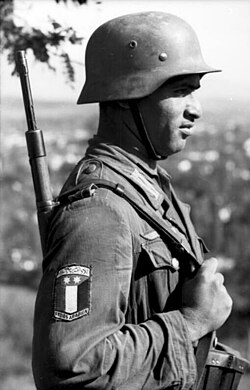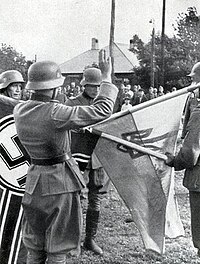Wehrmacht foreign volunteers and conscripts


Among the approximately one million foreign volunteers and conscripts who served in the Wehrmacht during World War II were ethnic Belgians, Czechs, Dutch, Finns, Danes, French, Hungarians, Norwegians, Poles,[1] Portuguese, Swedes,[2] Swiss along with people from Great Britain, Ireland, Estonia, Latvia, Lithuania, and the Balkans.[3] At least 47,000 Spaniards served in the Blue Division.[4]
Many Soviet citizens (Russians and other non-Russian ethnic minorities) joined the Wehrmacht forces as Hiwis (or Hilfswillige).[5] The Ukrainian collaborationist forces were composed of an estimated number of 180,000 volunteers serving with units scattered all over Europe.[6] Russian émigrés and defectors from the Soviet Union formed the Russian Liberation Army or fought as Hilfswillige within German units of the Wehrmacht primarily on the Eastern Front.[7] Non-Russians from the Soviet Union formed the Ostlegionen (literally "Eastern Legions"). The East Legions comprized a total of 175,000 personnel.[8] These units were all commanded by General Ernst August Köstring (1876−1953).[9] A lower estimate for the total number of foreign volunteers that served in the entire German armed forces (including the Waffen SS) is 350,000.[10]
These units were often under the command of German officers and some published their own propaganda newssheets.
List of units
[edit]



Soviet Union
[edit]| Unit name | Description |
|---|---|
| Mostly Soviet Armenians | |
| Mostly Soviet Azeris | |
| Mostly Soviet Georgians | |
| Hiwi | Soviet civilians and prisoners of war |
| XV SS Cossack Cavalry Corps | Until 1 February 1945 under command of the Wehrmacht, then the Corps was transferred to the Waffen-SS[11] |
| Kalmykian Voluntary Cavalry Corps | Mostly Kalmyks |
| Litauische Bau-Bataillonen | Mostly conscripted Lithuanians |
| Fatherland Defense Force | Land unit composed of Lithuanians |
| Air unit composed of Latvians. | |
| Nachtigall Battalion | Ukrainians of the Organization of Ukrainian Nationalists |
| Ostlegionen | Consisting mostly of Caucasians |
| Roland Battalion | A.k.a. Special Group Roland. Second Polish Republic citizens of Ukrainian ethnicity |
| Mostly ethnic Russians | |
| Formed in May 1943 and comprised 5 Azeri and 6 Turkestani artillery/infantry units.[12] | |
| Ukrainians | |
| Ukrainians |
Croatia
[edit]Middle East
[edit]- Legion Freies Arabien (Arab volunteers)
- Deutsch-Arabische Lehr-Abteilung (Arab volunteers)
- Deutsch-Arabisches Bataillon Nr. 845 (Arab volunteers)
- Freiwilligen-Stamm-Regiment 1 (Turkish volunteers)
Azerbaijani, Georgian and Armenian volunteers
[edit]- Armenische Legion (Armenian volunteers)
- Aserbaidschanische Legion (Azerbaijani volunteers)
- 30. Waffen-Grenadier-Division der SS (Russische Nr. 2)
- Georgische Legion (Georgian volunteers)
- Freiwilligen-Stamm-Regiment 1 (Georgian volunteers)
- Freiwilligen-Stamm-Regiment 2 (Armenians & Azerbaijanis)
- Sonderverband Bergmann (Georgian and Azerbaijani volunteers)
- I. Sonderverband Bergmann Battalion (Georgian volunteers)
- III. Sonderverband Bergmann Battalion (Azerbaijani volunteers)
- SS-Waffengruppe Georgien (Georgian volunteers)
- SS-Waffengruppe Armenien (Armenian volunteers)
- SS-Waffengruppe Aserbaidschan (Azeri volunteers)
North Caucasian volunteers
[edit]- Kaukasisch-Mohammedanische Legion (Azerbaijani, Circassian, Daghestani, Chechen, Ingush, and Lezghin volunteer units)
- Kaukasischer-Waffen-Verband der SS or Freiwilligen Brigade Nordkaukasien (volunteers from the North Caucasus region)
- Nordkaukasische Legion ("North Caucasian Legion" volunteers from the North Caucasus region)
- Freiwilligen-Stamm-Regiment 1 (North Caucasian volunteers)
- Sonderverband Bergmann (North Caucasian volunteers)
- II. Sonderverband Bergmann Battalion (North Caucasian volunteers)
- SS-Waffengruppe Nordkaukasus (North Caucasian volunteers; Chechens, Ingush & Dagestani)
Central Asian volunteers
[edit]- 162. (Turkistan) Infanterie-Division (Turkestani volunteers)
- Muselmanischen SS-Division Neu-Turkistan (Turkestani volunteers)
- Turkistanische Legion (volunteers from Central Asia; Uzbeks, Kazakhs, Kyrgyzs & Turkmen)
- Böhler-Brigade (Turkestani volunteers)
- 1. Turkestanisches-Arbeits-Battalion (Turkestani volunteers)
- 2. Turkestanisches-Arbeits-Battalion (Turkestani volunteers)
- 3. Turkestanisches-Arbeits-Battalion (Turkestani volunteers)
- Osttürkischer Waffen-Verband der SS or 1. Ostmuselmanisches SS-Regiment (Central Asia volunteers)
- Turkestanisches-Arbeits-Ersatz-Battalion (Turkestani volunteers)
- Waffen-Gruppe Turkistan (Central Asian volunteers)
Kalmykian volunteers
[edit]- Kalmüken Verband Dr. Doll (Kalmykian volunteers)
- Abwehrtrupp 103 (Kalmykian volunteers)
- Kalmücken Legion or Kalmücken-Kavallerie-Korps (Kalmykian volunteers)
Tatar volunteers
[edit]- Tatar Legion
- SS-Waffengruppe Idel-Ural (Turkic volunteers from Volga/Ural area)
- Waffen-Gebirgs-Brigade der SS (Tatar Nr. 1) (Tatar volunteers)
- 30. Waffen-Grenadier-Division der SS (Russische Nr. 2) (Armenian & Tatar volunteer units)
- Wolgatatarische Legion (Volga Tatars and Volga-Finns)
- Tataren-Gebirgsjäger-Regiment der SS (Crimean Tatar volunteers)
- Waffen-Gruppe Krim (Crimean Tatar volunteers)
- Schutzmannschaft Battalion (Crimean Tatar volunteers)
Cossack volunteers
[edit]- 1. Kosaken-Kavallerie-Division (volunteers from Cossacks in Cherson, from February 1945 XV. SS-Kosaken-Kavallerie-Korps)
- Kosaken-Reiter-Brigade Kaukasus II (Caucasus Cossack volunteers)
- Kuban-Kosaken-Reiter-Regiment 3 (Kuban Cossack volunteers)
- Don-Kosaken-Reiter-Regiment 5 (Don Cossack volunteers)
- Terek-Kosaken-Reiter-Regiment 6 (Terek Cossack volunteers)
- Kosaken-Artillerie-Regiment 2 (Caucasian Cossack volunteers)
- Sibirisches Kosaken-Reiter-Regiment 2 (Siberian Cossack volunteers)
- XV. Kosaken-Kavallerie-Korps (Kotelnikovo Cossack volunteers)
- Freiwilligen-Stamm-Regiment 5 (Cossack volunteers)
Caucasian mixed volunteer units
[edit]- Freiwilligen-Stamm-Division (Georgian, Turkish, North Caucasian, Armenian & Azerbaijani volunteers)
Caucasian, Central Asian, Crimean and Ural mixed volunteer units
[edit]Propaganda newspapers for Caucasian and Cossack units
[edit]- Azerbaijan
- Azerbajçan – Azerbaijani Legion
- Kalmykia
- Kalmyckij Boec ("Kalmyk Soldier") – Kalmyk Cavalry Corps
- Kosaken (Cossack Nation)
- Kosaken-Illustrierte ("Cossack Illustrated") – 1st Cossack Cavalry Division (trilingual)
- La terra dei cosacchi ("The Land of the Cossacks") – Cossack units in upper Italy
- Krimtürken (Crimean Tatars)
- Kirim ("Crimea") – Weekly paper for the Crimean Tatar volunteers, Berlin 1944–1945
- Tataren (Tatar nation)
- Deutsch-tatarisches Nachrichtenblatt ("German-Tatar News Journal") – Volga Tatar Legion, monthly publication, Berlin 1944–1945 (bilingual)
- Turkestaner (Central Asian nation)
- Yeni Türkistan ("New Turkestan") – Turkistan Legion
- Svoboda ("Freedom") – 162nd Turkoman Division
- Türk Birligi ("Turkish Unity") – Osttürkischer Waffen-Verband der SS, weekly publication, Berlin 1944–1945
German commanders of Central Asian, Caucasian and Cossack units
[edit]These German commanders also received honorary military or leading titles between their units at charge; for example Helmuth von Pannwitz received the title of "Ataman" from his Cossack units.
- Generalleutnant Helmuth von Pannwitz
- Oberst Hans-Joachim von Schultz
- Oberstleutnant Günther von Steinsdorff
- Oberst von Baath
- Oberst Freiherr von Nolcken
- Oberst Konstantin Wagner
- Sonderführer Othmar Rudolf Wyrba a.k.a. "Dr. Doll" (German, Tibetan and Mongolian language expert; leader of the Kalmuck units)
- Oberstleutnant Pipgorra
- Oberst Raimund Hoerst
- SS-Obersturmbannführer Andreas Meyer-Mader
- SS-Hauptsturmführer Billig
- SS-Hauptsturmführer Hermann
- SS-Sturmbannführer der Reserve Franz Liebermann
- SS-Hauptsturmführer Reiner Olzscha
- SS-Hauptsturmführer Fürst
- SS-Standartenführer Harun-el-Raschid Bey (of the central Asian legions; was a German who converted to Islam while serving as an advisor to Enver Pasha)
- Generalmajor Prof. Dr. Oskar Ritter von Niedermayer
- Generalleutnant Ralph von Heygendorff
German representative of the Ministry for the Occupied Eastern Territories
[edit]Central Asian, Caucasian and Cossack political leaders
[edit]- Cossack Ataman General Pyotr Krasnov
- Cossack Ataman General Andrei Shkuro
- Cossack Ataman Vasili Glazkov
- Kalmuk Prince Tundotov
Puppet governments and organizations in the USSR
[edit]- Provisional Government of Lithuania
- Zuyev Republic
- Belarusian Central Council
- Lokot Autonomy (later Lepel Republic)
- Ukrainian National Government
- Ukrainian National Committee
- Provisional Popular Revolutionary Government of Chechnya-Ingushetia
- Liberation Movement of the Peoples of Russia
- North Caucasus National Committee
- Turkestan National Committee
- Patriotic Union Tetri Giorgi
- Cossack Central Office
- National Karachai Committee
- Armenian National Committee
- Kalmyk National Committee
- Simferopol Muslim Committee
- Tatar Committee
- Eastern Turkish Council
- Caucasian Council
- Cossack National Liberation Movement
- Main Board of the Cossack Forces
- Russian Committee in Latvia
- Belarusian Committee (Warsaw)
- Belarusian Committee (Białystok)
- Belarusian Representation
- Belarusian Self-Help Committee
- Belarusian National Center
- Belarusian Cultural Assembly
- Committee to Combat Bolshevism
- Russian Committee
- Caucasian Committee in the General Government
- Commission for Cossacks
- Gathering of the nations enslaved by Russia
Other
[edit]See also
[edit]- Collaboration with the Axis Powers during World War II
- Georgian uprising on Texel
- Waffen-SS foreign volunteers and conscripts
- Non-Germans in the German armed forces during World War II
- 361st Infantry Regiment (Wehrmacht) - recruited among Germans from the French Foreign Legion
- Selbstschutz
References
[edit]- ^ Ryszard Kaczmarek: Polacy w Wehrmachcie. Wydawnictwo Literackie, Kraków 2010. ISBN 978-83-08-04488-9
- ^ Wangel, Carl-Axel (1982). Sveriges militära beredskap 1939-1945 (in Swedish). Stockholm: Militärhistoriska Förlaget. ISBN 978-91-85266-20-3.
- ^ Grasmeder, Elizabeth M.F. "Leaning on Legionnaires: Why Modern States Recruit Foreign Soldiers". International Security. Retrieved 30 July 2021.
- ^ "Spain's Nazi volunteers defend their right to recognition - and German pensions". The Daily Telegraph. 30 November 2015.
- ^ Audrey L. Alstadt (2013). "The Azerbaijani Turks: Power and Identity under Russian Rule". p. 187. ISBN 9780817991838
- ^ Carlos Caballero Jurado (1983). Foreign Volunteers of the Wehrmacht 1941–45. Translated by Alfredo Campello, David List. Osprey. p. 29. ISBN 978-0-85045-524-3.
- ^ M. V. Nazarov, The Mission of the Russian Emigration, Moscow: Rodnik, 1994. ISBN 5-86231-172-6[page needed]
- ^ "Slaughter on the Eastern Front: Hitler and Stalin's War 1941-1945" Appendix 3
- ^ Dermot Bradley, Karl-Friedrich Hildebrand, Markus Rövekamp: Die Generale des Heeres 1921–1945. Band 7: Knabe–Luz. Biblio Verlag, Bissendorf 2004, ISBN 3-7648-2902-8.
- ^ "SS: Hitler's Foreign Divisions" description
- ^ Rolf Michaelis: Die Waffen-SS. Mythos und Wirklichkeit. Michaelis-Verlag, Berlin 2001, p. 36
- ^ Nikolai Tolstoy (1977). The Secret Betrayal. Charles Scribner's Sons. pp. 304ff. ISBN 0-684-15635-0.
- ^ Carlos Caballero Jurado; Ramiro Bujeiro (2009). Blue Division Soldier 1941-45: Spanish Volunteer on the Eastern Front. Osprey Publishing. p. 34. ISBN 978-1-84603-412-1.
Bibliography
[edit]- Jurado, Carlos Caballero (1985). Foreign volunteers of the Wehrmacht 1941-45. London: Osprey. ISBN 0-85045-524-3. OCLC 13216649.
- Elizabeth M.F. Grasmeder, "Leaning on Legionnaires: Why Modern States Recruit Foreign Soldiers," International Security (July 2021), Vol 46 (No. 1), pp. 147–195.
Further reading
[edit]- Elizabeth M.F. Grasmeder, "Leaning on Legionnaires: Why Modern States Recruit Foreign Soldiers," International Security (July 2021), Vol 46 (No. 1), pp. 147–195.
- Edele, Mark (2017). Stalins' Defectors: How Red Army Soldiers Became Hitler's Collaborators, 1941-1945. Oxford: Oxford University Press. ISBN 978-0-19-879815-6.
